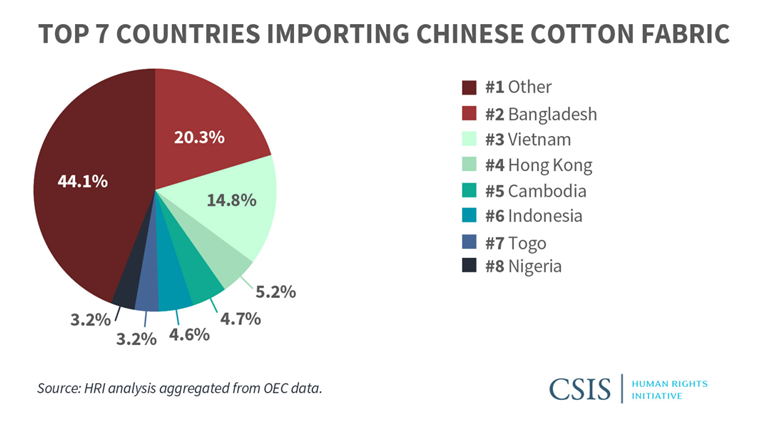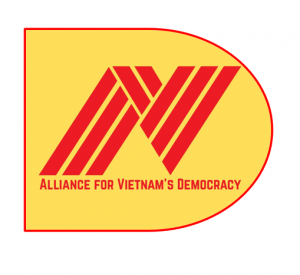
VIETNAMESE ORGANIZATIONS URGE US INSPECTION OF COTTON FABRIC FROM VIETNAM

CSIS Human Rights Initiative
Groups urge the presumption of forced labor should also be extended to cotton fabric imported from Vietnam, which alledgedly is importing cotton from Xinjiang.
SAIGON, VIETNAM, March 27, 2022 /EINPresswire.com/ -- On December 23, 2021, President Biden signed the Uyghur Forced Labor Prevention Act into law. The legislation, which received widespread bipartisan support in Congress, is an effort to address forced labor in Xinjiang or East Turkestan region. It creates a rebuttable presumption that goods produced in whole or in part in the Xinjiang are produced with forced labor and therefore prohibited from importation.
The Alliance for Vietnam’s Democracy, an alliance of several Vietnamese organizations, released a statement today prior to the end of the legislation’s public comment period. The alliance alleges that Vietnam has been importing Xinjiang cotton to supply increased market share, helping China bypassing the US sanction prescribed in the Uyghur Forced Labor Prevention Act.
According to the World Bank, between 2002 and 2020, China was by far the largest source of garment imports into the US. In 2020, just when the Trump administration started an import ban on all cotton from western China’s Xinjiang, Vietnam suddenly outstripped China as the biggest exporter of garments to the US market, from 16 percent market share the year before.
As of 2019, 85% of cotton grown in China is produced in Xinjiang, constituting approximately 22% of global cotton. In the last several years, China has encouraged the rapid growth of textile and apparel manufacturing in the Uyghur Region. Nonetheless, international shipping records indicate that cotton goods export shipments from the Uyghur Region direct to the United States have nearly ceased altogether in the last two years. The statement suggests that the cotton and cotton-based yarn, textiles, and finished garments grown and manufactured for export in the Uyghur Region must be transported from the region to Vietnam and other locations before being shipped internationally.
While the United States remained the largest consumer of finished apparel from China, the top two destinations (in terms of both value and weight) for China’s export of raw cotton, yarn, and fabric are Bangladesh and Vietnam.
Out of the 53 international intermediary manufacturers that purchase unfinished cotton goods from five leading Chinese manufacturers that have sourced Xinjiang cotton, six are from Vietnam. The Alliance for Vietnam's Democracy cautioned that “several well-known international brands are supplied by those Vietnamese intermediaries and are thus at high risk of having Xinjiang cotton in their supply chains.”
UN Comtrade data reveals that more than half of China’s exports of cotton semi-finished products are destined for countries within Asia, with Vietnam the second most popular destination. Analysis of shipping data suggests that, once there, international intermediary manufacturers produce finished garments from the semi-finished products for export around the world, often with the precise composition of the materials supplied by the suspect Chinese suppliers.
The effect is a “laundering” of Xinjiang cotton—obscuring its movement so that the provenance of a finished garment’s cotton becomes difficult to detect. According to Laura Murphy of the Helena Kennedy Centre for International Justice: "The benefits of such an export strategy may be clear: the end buyer is no longer directly involved in buying Xinjiang cotton—international brands and wholesalers can buy from factories in third countries that have few visible ties with Uyghur Region-based companies. A stable supply of Xinjiang cotton to the international market is thus guaranteed, even as brands, governments, and consumers increasingly turn away from Xinjiang forced-labor-made goods."
Vietnam is the fourth largest importer of cotton or cotton-mixed products from China between 2016 and 2019 in terms of product value ($20 billion) and second in term of weight (2 billion kg). The country is also the second largest export destinations of semi-finished cotton products from China in terms of value ($7.3 billion) and weight (939.3 million kg).
Vietnam, one of the top imports, is also home to a high number of export-grade apparel manufacturers.
All five Chinese cotton enterprises that have been supplied by the Uyghur Region’s cotton industry, Jiangsu Lianfa Group, Luthai Textile Co., Huafu Fashion Co., Texhong Textile Group, and Weiqiao Textile Co., export a significant number of shipments of cotton goods to Vietnam for intermediary manufacturing. One company, Huafu, has production bases in the Xinjiang Uyghur Autonomous Region. Additionally, it has established production facilities in Vietnam. Both Luthai Textile Co. and Texhong Textile Group have also established production bases in Vietnam.
China is also the world’s largest apparel producer. Most of these textiles and apparel are exported to the United States, Japan, Vietnam, Hong Kong, Germany, South Korea, and the United Kingdom. Vietnam is also a top exporter of textiles.
The Uyghur Forced Labor Prevention Act creates a rebuttable presumption that goods produced in whole or in part in the Xinjiang are produced with forced labor and therefore prohibited from importation. The statement from the Alliance for Vietnam’s Democracy urges, in order to comply with this legislation, “the presumption should also be extended to cotton fabric imported from Vietnam, which, in turn, is importing cotton and other predecessors of finished apparel from Xinjiang.”
Dr. David Tran, MD
Alliance for Vietnam's Democracy
email us here
Visit us on social media:
Facebook
EIN Presswire does not exercise editorial control over third-party content provided, uploaded, published, or distributed by users of EIN Presswire. We are a distributor, not a publisher, of 3rd party content. Such content may contain the views, opinions, statements, offers, and other material of the respective users, suppliers, participants, or authors.


